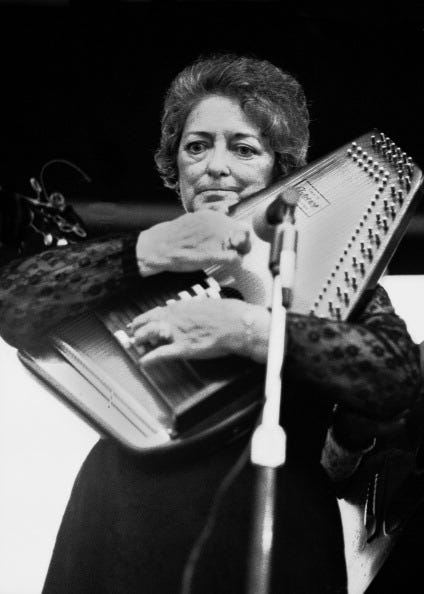“In an Iridescent Time” by Ruth Stone from What Love Comes To: New and Selected Poems. © 1959 by Ruth Stone.
ORIGINAL TEXT AND AUDIO - 2017
It’s the birthday of country and folk musician Mother Maybelle Carter, born Maybelle Addington in a tiny hamlet near Nickelsville in western Virginia. (1909). She revolutionized guitar playing with her unusual style of playing melody on the bass strings: she used her thumb while strumming with her fingers. This method became known as “the Carter Scratch” and turned the guitar from a purely rhythm instrument to a lead instrument.
Carter’s entire family was musical and Maybelle grew up playing banjo and Autoharp. She moved to the guitar as a teenager. Her mother played banjo and sang old Appalachian folk songs and hymns. When Maybelle was 15, she dropped out of school to play music with her cousin, Sara, and Sara’s husband, A.P. Carter.
When Maybelle was seven months pregnant, A.P. Carter promised Maybelle’s husband, Ezra — who was also A.P.’s brother — that he’d weed his corn patch if he let Maybelle come along to Bristol, Tennessee, to make a record. Maybelle, Sara, and A.P., had been performing regularly at fairs, schools, and churches as “The Carter Family,” and had gotten pretty popular in Virginia. A man named Ralph Peer of the Victor Talking Machine Company wanted to record gospel and string bands. Ezra agreed, and lent The Carter Family his rickety Model T.
The Carter Family performed several songs for Peer above a hat shop in Bristol. He paid $50.00 on the spot and promised a royalty of 2½ cents for each single sold. The heavy, spinning turntable, covered with an inch and half of wax, astonished Maybelle. There were pulleys and weights in a wooden tower. The microphone even ran off electricity. She said: “When we made the record and played it back, I thought it couldn’t be. I just couldn’t believe it, this being so unreal, you standing there and singing and they’d turn around and play it back to you.”
The Carter Family finished up the record and went home. A year later, the record they’d made, filled with rural songs like “Single Girl, Married Girl,” and “Wandering Boy,” had sold nearly 300.000 copies. The Carter Family was the first vocal group to become country music stars.
When The Carter Family broke up, Mother Maybelle simply formed a new band with her daughters. “Mother Maybelle and The Carter Sisters” became a staple of the Grand Ole Opry in Nashville and toured with Johnny Cash and Elvis Presley. Maybelle’s daughter June later married Johnny Cash and wrote the one of the most famous songs in country music about their relationship, “Ring of Fire.”
In the 1960s, music from The Carter Family archives became quite popular on college campuses, with young people starting an Autoharp craze because of Maybelle Carter. She was so enamored of the counterculture’s enthusiasm for Carter Family music that she considered performing a cover of the song “One Toke Over the Line,” until one of her daughters told her what the song was really about. In the mid-1960s, she and Sara reunited to record an album called An Historic Reunion — and it was. Maybelle Carter died in 1978.
Billboard Magazine called the Bristol sessions “the most important single event in the history of country music.”
J. Edgar Hoover was named acting director of the FBI on this date in 1924, beginning a term that would span nearly 50 years, and establish the United States Department of Justice as we know it today.
Hoover was born to two government civil servants in Washington, D.C., in 1895. He took a job with the Library of Congress right out of high school and took night classes to earn his law degree. He graduated in 1917 and joined the Justice Department. He rose through the ranks quickly and was soon appointed leader of the General Intelligence Division. He was the driving force behind the “Palmer Raids” of 1919 — a series of raids conducted without search warrants that led to the arrest of hundreds of suspected radicals.
He made no secret of his ambition to run the Bureau of Investigation, as it was known then. President Calvin Coolidge named him acting director in May 1924, and he was formally named director by the end of the year. He made it his mission to separate the bureau from politics, and fired anyone who was, in his view, a political appointee. He made it more difficult to become an agent — candidates must pass rigorous interviews, background checks, and physical tests, and at one point it was said to be harder to get into the Bureau of Investigation than it was to get into an Ivy League college. Hoover also established forensic evidence labs. He took on gangsters and organized crime in the 1930s, arguing that because gangsters crossed state lines, they could and should be apprehended by federal agents, rather than state and local law enforcement, whose resources were often inadequate to the task.
Hoover also made it the mission of the bureau to root out suspected subversives and communists during the Cold War. To get around the restrictions placed by the Supreme Court on the agency’s investigations, he formed the Counter Intelligence Program. COINTELPRO went after any groups that Hoover considered subversive, including the KKK, the Black Panthers, and the Civil Rights Movement. He criticized a free breakfast program for urban poor children that was run by the Black Panthers, saying it was a recruitment tool for the organization and called the program “potentially the greatest threat to efforts … to neutralize the BPP and what it stands for.” He ordered illegal wiretaps, searches, and even burglaries to compile files on many parties, including Martin Luther King Jr., whom Hoover “the most dangerous Negro in the future of this nation.” He also kept immense files on Albert Einstein, Marilyn Monroe, and Elvis Presley. When Charlie Chaplin — whose FBI file was almost 2,000 pages long — left the United States for a promotional tour in Europe in 1952, Hoover revoked his re-entry permit. Hoover also pushed to have John Lennon’s immigrant visa revoked; he had a huge file on Lennon that was kept under wraps until just a few years ago, and when it was released, it turned out that most of the information it contained was already common knowledge. A memo in the file reads: “Lennon has encouraged the belief that he holds revolutionary views, not only by means of his formal interviews with Marxists, but by the content of some of his songs and other publications.”
No president was willing to fire Hoover, or even ask him to retire, even when he passed the government’s mandatory retirement age of 70. Lyndon Johnson was quoted as saying, “It’s probably better to have him inside the tent pissing out, than outside the tent pissing in.” Hoover died in office in 1972, at the age of 77.
It’s the birthday of British-American novelist Barbara Taylor Bradford, born in Armley, England (1933). She is best known for her debut novel, A Woman of Substance (1979), which went on to sell 30 million copies worldwide. Her secret is simple: write about smart, conflicted, powerful, and attractive women. Bradford says: “I think women like to read about other women who succeed. When I was growing up, I was always interested in reading about people who made something of themselves, women who made a difference.”
Bradford’s other books include Power of a Woman (1997) and Secrets of the Past (2012). She’s written over 30 books and each one has been a best-seller.
When asked what advice she’d give to aspiring novelists, Bradford said: “You can’t be a novelist if you can’t imagine things happening that have never happened; you need to be a really good liar. A novel is a monumental lie that has the ring of truth.”
It’s the birthday of British-American astronomer Cecilia Payne-Gaposchkin, born in Wendover, England (1900). She was the first woman to earn her Ph.D. in astronomy at Harvard, where several years before, Annie Jump Cannon and her fellow female colleagues had catalogued over 200,000 stars. Payne-Gaposchkin’s advanced degree brought women into the academic mainstream for the first time in the field. Still, she faced unfair gender bias for the rest of her life. Though she spent her entire career teaching and conducting research at Harvard, she was for many years denied an official position and commensurate pay. Payne-Gaposchkin was a role model for Joan Feynman, whose mother discouraged her from entering science even as she encouraged her famous physicist brother, Richard, to pursue it. Encouraged by Payne-Gaposchkin’s example, Joan Feynman went on to become an astrophysicist herself, and eventually uncovered the origins of the Northern Lights.
Be well, do good work, and keep in touch.®
A Prairie Home Companion Scroll T-shirt






Thank you for including Maybelle Carter in your research and presentations. Perhaps the Stoneman Family? One of my favorite groups, with a fluid complement, the onstage group might have sons and daughters, cousins, grandchildren.... , Pop Stoneman was once asked how he came to have such a large family, he said it was because his wife was hard of hearing. When he came home from his work in the mine, he would clean up, have dinner, help the kids with homework, and when they were put to bed, he would ask his wife, "so, do you want to go to bed, or what?" and she would reply "What?"....